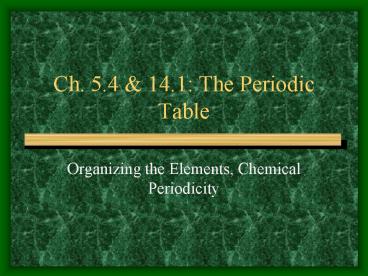Ch' 5'4 - PowerPoint PPT Presentation
1 / 23
Title:
Ch' 5'4
Description:
Periods = horizontal rows; contain increasing numbers of protons and ... Have luster. Malleable. Ductile. Metals (have 3 or less electrons in outer level, thus ... – PowerPoint PPT presentation
Number of Views:19
Avg rating:3.0/5.0
Title: Ch' 5'4
1
Ch. 5.4 14.1 The Periodic Table
- Organizing the Elements, Chemical Periodicity
2
Organizing the elements Periodic repeated in a
pattern
Medeleev late 1800s, ordered elements by atomic
masses predicted the properties of undiscovered
elements
3
- Changes needed to be made
- 1913 Moseley arranged elements by atomic
- current table is arranged this way
4
Periods horizontal rows contain increasing
numbers of protons and electrons (elements in the
same period have the same energy level,
n) Periodic Law when elements are arranged in
order of increasing atomic number, there is a
periodic repetition of their physical and
chemical properties. (Thus, elements in columns
have similar properties).
5
Vertical Columns Groups or Families share
similar chemical and physical properties because
they have the same number of valence electrons
There are two groups (A and B)
6
Group A elements are all representative elements
exhibit a wide range of both chemical
physical properties Representative elements
(divided into 3 classes)
1. metals (80 of the elements)
2. nonmetals
3. metalloids
7
Metals
- Conductors
- Have luster
- Malleable
- Ductile
8
Metals (have 3 or less electrons in outer level,
thus tend to form cations) -Alkali Metals
(Group 1A) -Alkaline Earth Metals (Group 2A)
Note Group B elements are also metals
(these are transition and inner- transition
metals)
9
Alkali Metals
- Group 1A 1 e- in outer level so combine readily
making the atom a 1 ion - Softer than other metals
- Most reactive not found in nature in elemental
form
10
Alkaline Earth Metals
Uses Fireworks strontium, magnesium Ladders,
vehicles- magnesium Bones, statues, countertops
calcium Disease diagnoses - barium
- Group 2A 2 valence electrons, 2 ions
- Not found in nature
11
Transition Inner Transition Elements Group B
Transition outermost s sublevel and nearby d
sublevel contain electrons
- Groups 3-12
- Occur in nature
- Often form colored compounds
12
Iron Triad Fe, Co, Ni
Fe most widely used metal main ingredient in
steel abundant in Earths crust
Ni used to coat other metals
Co Ni used in some steels
13
Coinage Metals Cu, Ag, Au
- Cu used in electrical wiring due to
conductivity and cost - Ag photographic film jewelry
- Au jewelry
- All stable and malleable
14
Group 12 Zn, Cd, Hg
- Zn Cd protective quality, used as coating
- Hg thermometers, thermostats, batteries,
poisonous
15
Inner Transition Metals Rare-Earth
- 2 rows disconnected
- 1st row Lanthanides
- 2nd row Actinides unstable ex. U
- Outermost s sublevel nearby f sublevel contain
electrons
16
Nonmetals
- Properties of Nonmetals
- Have 5 or more electrons in the outer level and
tend to form anions - Usually gases or brittle solids at room temp.
- All except H, right of stair-step
- Not malleable or ductile
- Poor conductors
- Not lustrous
17
HYDROGEN
- Most abundant element in universe 90
- Highly reactive
- Diatomic molecule 2 atoms of the same element
in covalent bond (BrINClHOF) - 1 valence e-
18
- Group 17 (7A) 7 valence e-
- If an e- is gained from a metal, then a salt is
formed ex NaCl - Very reactive
- Distinctive colors
- F is most chemically reactive of all elements
The Halogens
19
Uses of Halogens
- Cl disinfectants bleach
- Br only nonmetal liquid at room temp.dyes
- I hormone regulation in body purple solid that
sublimes (solid?gas)
20
The Noble Gases inert gases
- Group 0 stable atoms outermost s p sublevels
are filled - No known naturally occurring compounds
21
Uses of Noble Gases
- He used in blimps balloons
- Ne, Ar, Kr used in lasers lights
22
Mixed Groups
- Metalloids
- Have some metallic some nonmetallic properties
- Form ionic covalent bonds
- Semiconductor characteristics due to partial
conduction
23
Block diagram read like a book
What are all the elements that have s2 for their
outer configurations?































